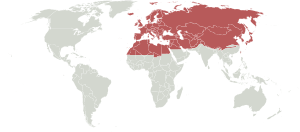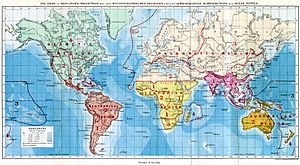Palearctic realm facts for kids
The Palearctic (say: Pay-lee-ARK-tik) is the biggest of Earth's eight main natural areas, called biogeographic realms. It covers a huge part of Eurasia (that's Europe and Asia combined) north of the Himalayas mountains, and also includes North Africa.
This giant area is made up of several smaller natural regions. These include the Euro-Siberian region, the Mediterranean Basin, the Sahara and Arabian Deserts, and parts of Western, Central, and East Asia. The Palearctic also has many important rivers and lakes.
The name 'Palearctic' was first used in the 1800s. It's still used today to help scientists classify where animals live around the world.
Contents
How the Palearctic Was Discovered
In 1858, a British zoologist named Philip Sclater first named six big natural areas on Earth. These included the Palearctic, along with others like the Afrotropic (Africa) and Australasia. Sclater grouped animals based on where they lived and how large natural barriers, like mountains or oceans, stopped them from moving.
Later, in 1876, Alfred Russel Wallace used Sclater's ideas in his famous book, The Geographical Distribution of Animals. This system is still used today, with only a few small changes. Two more realms, Oceania and the Antarctic realm, were added later.
Main Natural Regions of the Palearctic
The Palearctic realm mostly has areas with cool or cold climates. These stretch across Eurasia, from western Europe all the way to the Bering Sea.
Euro-Siberian Region
The Euro-Siberian region is the largest part of the Palearctic. It changes from very cold, treeless tundra in northern Russia and Scandinavia to huge taiga forests. Taiga forests are made up of evergreen trees and stretch across the continent. South of the taiga, you'll find forests with many different kinds of trees, both broadleaf and evergreen.
This huge region shares many plants and animals with the cool parts of the Nearctic realm (North America). Eurasia and North America were often connected by a land bridge called the Bering land bridge. Because of this, they have very similar mammals and birds. Many animals from Eurasia moved to North America, and some from North America moved to Eurasia. Some scientists even think the Palearctic and Nearctic are one big area called the Holarctic realm.
Mediterranean Basin
The lands around the Mediterranean Sea in southern Europe, north Africa, and western Asia are called the Mediterranean Basin. This area has a special mediterranean climate with mild, rainy winters and hot, dry summers.
This region has many different types of forests and woodlands. It's home to about 13,000 species of plants and animals that live only there (they are endemic). Sadly, the Mediterranean Basin is one of the most endangered natural areas. Only a small part of its original plant life remains. Human activities like overgrazing (too many animals eating plants), cutting down forests, and building cities have damaged much of the region. This area is so important that Conservation International calls it a biodiversity hotspot.
Sahara and Arabian Deserts
A huge belt of deserts, including the Sahara and Arabian desert, separates the Palearctic from the Afrotropic (African) natural areas. Some scientists include these deserts in the Palearctic. Others place the boundary differently, sometimes in the middle of the desert or at its northern edge.
Western and Central Asia
The Caucasus mountains, located between the Black Sea and the Caspian Sea, have a rich mix of forests. These include evergreen, broadleaf, and mixed forests. Some parts even have temperate rain forests.
Central Asia and the Iranian plateau are mostly dry steppe (grasslands) and desert areas. However, their high mountains have forests and grasslands. In southern Asia, the Palearctic boundary is mostly based on height. The lower parts of the Himalaya mountains (around 2000–2500 meters high) form the border between the Palearctic and the Indomalaya (Southeast Asian) natural areas.
East Asia
China, Korea, and Japan are wetter and have milder climates than nearby Siberia and Central Asia. They have rich evergreen, broadleaf, and mixed forests. Today, most of these forests are found in mountainous areas. This is because many people live in the lowlands, which have been turned into farms and cities.
East Asia was not affected much by the ice ages. Because of this, it kept most of its tree types from millions of years ago, unlike Europe, which lost many. In southern China and the southern edge of the Himalayas, the Palearctic forests mix with the warmer forests of Indomalaya. This creates a very rich and diverse mix of plants and animals. The mountains of southwest China are also a biodiversity hotspot.
Freshwater Areas
The Palearctic realm also has several important freshwater ecoregions. These include the busy rivers of Europe and the rivers of Russia, which flow into the Arctic, Baltic, Black, and Caspian seas. Siberia is home to Lake Baikal, which is the oldest and deepest lake on Earth. Japan has the ancient Lake Biwa.
Animals and Plants of the Palearctic
One family of birds, the accentors, lives only in the Palearctic region. The larger Holarctic area (Palearctic and Nearctic combined) has four other bird families that live only there: the loons, grouse, auks, and waxwings.
No entire groups of mammals (called orders) live only in the Palearctic. However, some mammal families are found only here. These include the mouse-like hamsters, pikas (small, rabbit-like animals), and red pandas. Many mammal species started in the Palearctic and then spread to North America during the Ice Age. These include the brown bear (known as the grizzly in North America), the red deer (and its close relative, the elk), the American bison, and the reindeer (called caribou in North America).
Giant Animal Extinctions
Several large animals that lived in the Palearctic became extinct from the end of the last Ice Age up to more recent times. These include the Irish elk (a giant deer), the aurochs (a type of wild cattle), the woolly rhinoceros, the woolly mammoth, and the cave bear.
Images for kids
See also
 In Spanish: Paleártico para niños
In Spanish: Paleártico para niños





